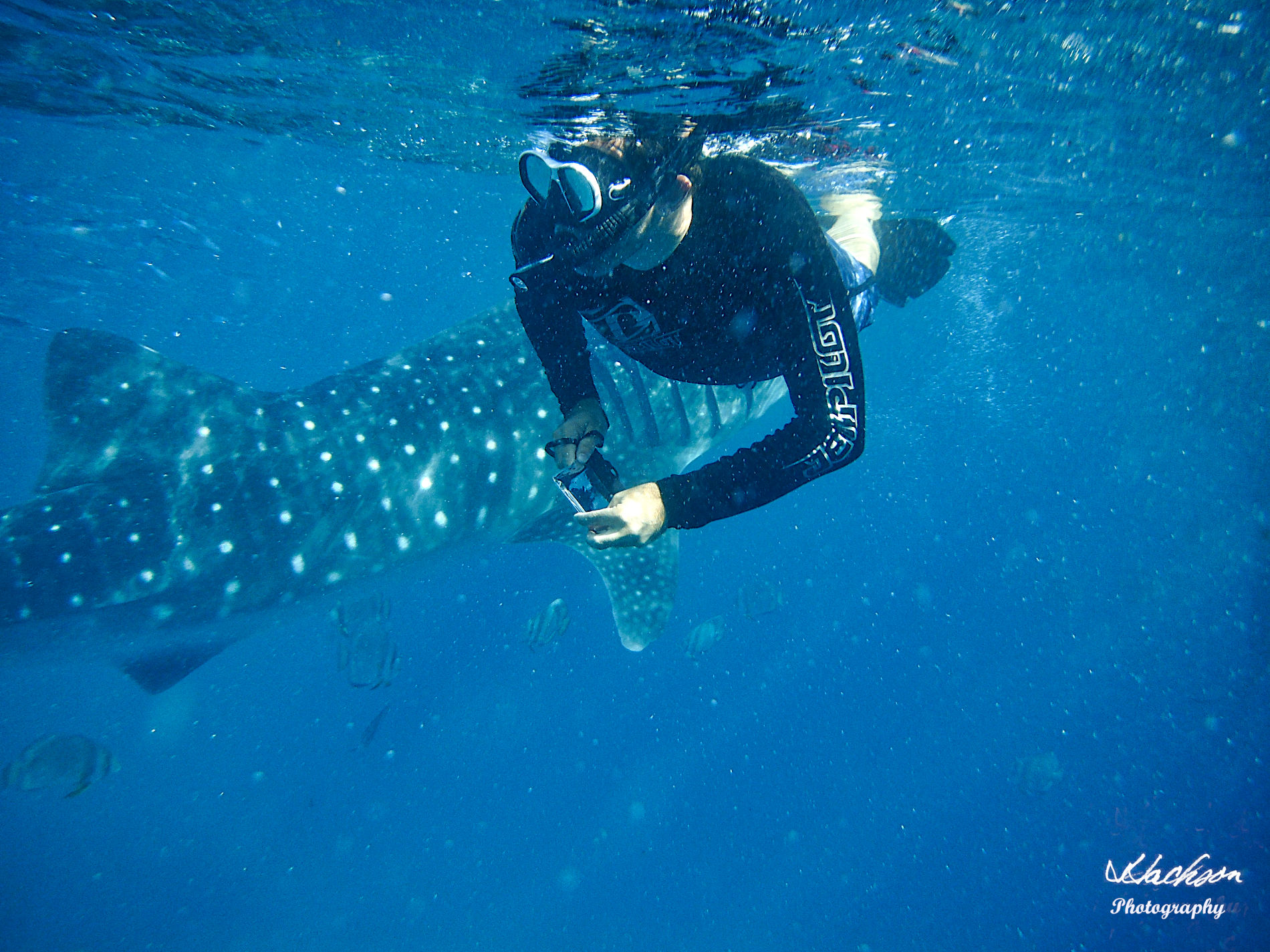Swimming with the Whale Sharks in Oslob, Cebu, Philippines

Numerous travel shows on television have featured whale sharks and the unique experience to swim with them, or dive with them if you are so inclined. And as with many ecotourist adventures, this one also comes with some degree of controversy. The leading controversy is that the same villagers of the small area of Oslob who had once hunted these magnificent creatures, now feed them to keep them coming back each day so that people can enjoy seeing them up close and personal.

Is it right that we humans do this? Of course, it is! We have destroyed so many habitats and we have depleted so many resources that most species depend on, so why not feed them? We have depleted the whale sharks’ source of food– plankton and small shrimp, that we either them, or they may die. One thing that you have to remember is that there are many people just like you who want to experience this amazing spectacle and there are a lot of people who go to Oslob just to see the whale sharks. Despite that large amount of ecotourists who come to swim with the whale sharks, it doesn’t feel crowded, especially when you are actually swimming with the sharks. And there are a lot of sharks!

Our adventure started at 3:30 am in Cebu City, some three hours away from Oslob. The actual dive location is Cangcua, Tan-Awan, Oslob, Cebu, Philippines, and we used Island Trek Tours, which I highly recommend. Their driver, Jerson, was extremely courteous and a very safe driver. His colleague, Carmel, who met us at Oslob, was amazing and was there to personally guide us through each step of the process. She purchased the tickets and even served us breakfast at our first restaurant stop of this adventure. She was very professional and even met us with a towel when our dive boat returned to shore.

Our first stop was at the restaurant which is owned by Island Trek Tours where we had a complimentary light breakfast of delicious sticky rice and a scrumptious mango that satisfied our early morning hunger. (You don’t want to eat too much before you dive as you may wind up feeding the fish!)

Above, sunrise in Oslob, Cebu, Philippines
There is no season for swimming with the whale sharks and you can enjoy this adventure every day and all year round, except when the waves are too high or when the weather is bad. We barely missed Typhoon Ursula that traversed through the Philippines on Christmas Eve and Christmas Day causing much damage and strong currents. Whale shark watching was obviously cancelled during that storm.

Once you finish your breakfast, you can head over to the dive site which is not very far away. The ticket booths open just after 6:30 am, in case you want to go do it alone without a guide. You will next go through a waiting period that includes a briefing of what you will see and what you are expected to do, like not touching or chasing the whale sharks. And of course, not to wear jewelry which you might drop in the ocean and never see again. Then the wait begins until they call your number. When your number is called, you pick up a life jacket, which you must wear in the boat but can shed it once you are at the dive site if you are a confident, good swimmer. You also get a mask and snorkel, but we brought our own since the “community” masks and snorkels may not get the best cleaning, if at all. You may want to bring your own. I also suggest that you bring an underwater camera, or you can rent one at a booth near the dive site for about US$10.00.

The boats are the traditional Philippine bangca outrigger canoes that are paddled to the dive site by experienced and very strong boatmen. No motors are allowed as they might frighten or injure the whale sharks. It takes only a few minutes for the boatmen to row you to the diving spot and you are allowed 30 minutes to swim alongside the boat as many whale sharks swim past you. By law, snorkelers must maintain a distance of four feet from the sharks and there is a fine and possible prison sentence for anyone who touches the animals. Maintaining the required distance may not be that easy as the whale sharks pay little attention to you and swim very, very close to you.
The last boat leaves the shore at about 11:00 am and the whale shark watching officially ends at noon, leaving the whale sharks to move on and look elsewhere in their never-ending quest for food.

What do we know about these magnificent creatures? Surprisingly not all that much. We do know that the whale shark (Rhincodon typus) is a very slow-moving, filter-feeding shark and the largest known existing fish species. They are found in the open waters of tropical oceans and rarely in water below 70 degrees F. Although there have been numerous unconfirmed reports of very large whale sharks, the largest confirmed was an individual that was 62 feet in length. The shear size of these sharks sets the record for the largest living vertebrate, in the non-mammal kingdom.

Although specific data does not exist, scientific modeling and estimates from data suggest that whale sharks have an average lifespan of about 70 years but may live as long as 130 years in the optimum conditions.
In April of 1828 the whale shark was first classified after a fifteen-foot specimen was harpooned in Table Bay, South Africa. The following year, a military doctor, Andrew Smith, detailed the fish; the name reflecting their size; being as large as some whales and having similar filter feeding habits like that of the baleen whale.


Whale sharks employ what is known as “ram filter feeding” whereby they swim directly toward their prey at a constant speed with their large mouth wide open. The fish sucks in the prey, straining it from the water by the force of their forward motion.


The mouth of the whale shark is very large and as “filter feeders” they can filter about 1,600 gallons of water per hour. They feed almost entirely on plankton, small shrimp and fish and are of no danger to humans unless an unwary ecotourist is accidently sucked into their mouth, which has happened on more than one occasion.

Whale sharks have over 26,000 very small teeth that are arranged in some 300 rows but provide no use in feeding. They employ the same feeding as do their relatives, the megamouth shark and the basking shark. They will eat copepods, krill, fish eggs, crab larvae and small nektonic life, such as small squid or fish. It also feeds on clouds of eggs during mass spawning of fish and corals. Whale sharks have also been observed feeding on small fishes that were caught in fishing nets. A juvenile whale shark can eat almost 50 pounds of plankton per day.

The skin of a whale shark is rough to the touch and is typically dark grey with an off-white color underside and belly. They are marked with spots and stripes of light grey or white which are unique to each individual whale shark much as fingerprints are to humans. Their heads are wide and flat with small eyes near the front of the head. Whale sharks have five large gills which are used to help filter water through the gigantic fish (they are not a mammal like an actual whale!).
Pregnant female whale sharks are what is called ovoviviparous, which means that they give birth to live young. The females carry their pups, which can be in the hundreds, and each newborn is almost 25 inches in length.


The tail of the whale shark consists of an upper and lower dorsal fin of which the upper is much larger. These heterocercal lobes are set far back of the body. They also have two pectoral fins, and two pelvic fins along with one medial anal fin. An adult can weigh up to 41,000 pounds!

Above, the comparative size of the swimmer (a male about six-feet tall) in comparison to the dorsal fins of the whale shark.
Since there is a lack of reliable data on total lengths that these species can reach, it is difficult to ascertain actual measurements and the associated inaccuracy of the measurements and the measurement techniques. Many whale sharks, when measured while the animal was alive, were measured under water using a comparison of the animal to a fixed object, like a coral reef or some other underwater object. And of course, the angle and position of the animal’s tail has a huge impact on the overall measurement. Most of the reported data, sadly, comes from individuals that were killed either by harpooning, getting entangled in fishing nests, hit by large ships or simply died and washed ashore.

Reports of large whale sharks:
In 1868, Edward Perceval Wright, a renown Irish natural scientist, was told of a whale shark in the Seychelles that exceeded 45 feet in length. Wright went on to claim that he observed one whale shark that exceeded 50 feet in length and another that was over 70 feet in length.

In 1925, Hugh M. Smith described in a magazine publication a whale shark that was caught in Thailand in 1919 in a bamboo fish trap. A Thai unit for measuring length is called a wa, which is the length of a mans outstretched arms, and this measurement technique showed the animal to be almost 60 feet. That unreliable measurement, however, based on a local fisherman’s report, has been called into question.

In 1934, a whale shark was struck by the ship Maunganui. The shark was stuck on the prow of the boat and apparently one side measured 15 feet while the other side measured 40 feet making this giant about 55 feet in length.

On November 11, 1949, it was reported that a 43,000-pound specimen over 38 feet long was caught near the Baba Island in Karachi, Pakistan.

In 1983 perhaps the most accurately measured whale up until 1997, was taken by a J. G. Coleman after the whale shark became entangled in a net off the coast of Mumbai. The detailed measurements found the animal to be 40 feet in length and weighing approximately 24,291 pounds.

In 1994, two whale sharks were captured off the coast of Tainan County, in the southern part of Taiwan. Using weight to length calculations, researchers estimated that one weighed 79,000 pounds and being 52 feet long. The other whale shark was estimated at weighing a staggering 93,000 pounds and being 57 feet in length.

Between 1994 and 1996, Scott A. Eckert and Brent S. Stewart tracked whale sharks via satellite. They reported that out of 15 individual whale sharks tracked, one female was reported as measuring 49 feet and another female measuring at 59 feet.

In 1995 there was a whale shark reported as being stranded along the Ratnagiri coast in the southwestern part of Maharashtra, India which measured just over 68 feet long.

In 2001 it was reported that a female whale shark nearly 62 feet in length was spotted in the Arabian Sea. A 2015 study that looked into the size of marine megafauna, considered the report on this female as being the most accurate and reliable measurement to date.

On February 7, 2012, a whale shark of about 39 feet in length and an estimated weight of 33,000 pounds was found floating about 93 miles off the coast of Karachi, Pakistan.

Whale sharks inhabit all tropical and warm-temperate seas, preferring the open oceans. They prefer shallow depths and can be seen close to land near coral reefs but have been known to dive to about 5,900 feet in depth. Beside the congregation at Oslob in the Philippines, whale sharks have been known to gather in other locations. In 2011 over 400 whale sharks assembled just off the coast of the Yucatan peninsula making this one of the largest gatherings ever reported.

Gathering of whale sharks during natural seasonal feeding occur throughout the world along numerous coastal sites: southern and eastern parts of South Africa; Saint Helena Island in the South Atlantic Ocean; Gulf of Tadjoura in Djibouti, Gladden Spit in Belize; Ningaloo Reef in Western Australia; Kerala, Lakshadweep, Gulf of Kutch and Saurashtra coast of Gujarat in India; Útila in Honduras; Southern Leyte; Cebu, Donsol, Pasacao and Batangas in the Philippines; off Isla Mujeres and Isla Holbox in Yucatan and Bahía de los Ángeles in Baja California, México; Maamigili island, Maldives; Ujung Kulon National Park in Indonesia; Cenderawasih Bay National Park in Nabire, Papua, Indonesia; Flores Island, Indonesia; Nosy Be in Madagascar; off Tofo Beach near Inhambane in Mozambique; the Tanzanian islands of Mafia, Pemba, Zanzibar; Gulf of Tadjoura in Djibouti, the Ad Dimaniyat Islands in the Gulf of Oman and Al Hallaniyat islands in the Arabian Sea; and, Eilat, Israel and Aqaba, Jordan.

On April 20, 2010 in the Gulf of Mexico, a BP operated oil well, the Macondo Prospect, created the largest oil spill in the history of the petroleum industry. The so-called Deepwater Horizon oil spill discharged an estimated 210 million US gallons of oil into what is considered a prime location for whale sharks in that part of the world where nearly one-third of these creatures were sighted. The sightings also confirmed that the whale sharks, with their pattern of surface filter feeding, were not able to avoid the massive oil slick in an area where they feed for several hours each day. Oddly there were no reports of whale shark deaths.
The Center for Biological Diversity in their report on the impact of the Gulf oil spill estimated that the BP spill “has likely harmed or killed approximately 82,000 birds of 102 species, approximately 6,165 sea turtles, and up to 25,900 marine mammals, including bottlenose dolphins, spinner dolphins, melon-headed whales and sperm whales. The spill also harmed an unknown number of fish — including bluefin tuna and substantial habitat for our nation’s smallest seahorse — and an unknown but likely catastrophic number of crabs, oysters, corals and other sea life. The spill also oiled more than a thousand miles of shoreline, including beaches and marshes, which took a substantial toll on the animals and plants found at the shoreline, including seagrass, beach mice, shorebirds and others.”
In the days just after the massive spill, BP CEO Tony Hayward, who was thrust onto the forefront of his company’s efforts to contain the Gulf of Mexico oil spill, callously remarked “I want my life back” to several news organizations, including Reuters. The oil rig explosion had killed 11 workers and untold animal life as well as having a major environmental impact, and this bonehead wants his life back!
It took five months to seal the massive oil leak yet reports that came in as late as 2012 indicate that the well site is still leaking oil.

Let’s go back to the issues raised about the ethicalness of the ecotourism industry and how it may or may not affect the whale sharks. The primary issues seem to be that it may harm them or have them become dependent on their handlers for food, and yet many of the detractors mention nothing about the harm humans do to the whale sharks habitat and their ceaseless hunting of these magnificent animals.
Although harm may be a relative term, the pod of 8 to 10 whale sharks that gather each day at Tan-Awan in Oslob are protected by the Philippine government and there are marine biologists who report their daily activities. No motors are allowed in the whale shark gathering area and those fishermen who had once hunted these great beasts, are now employed as guides.

So, are the whale sharks becoming dependent on the people who feed them? Perhaps, but once you consider all of the damage that we have done to their environment, like fishing by using dynamite on the coral reefs which destroyed a large portion of their original food sources, then maybe that’s not a bad thing. Besides, the amount of food that is given to them is actually quite small. An adolescent whale shark will eat about 50 pounds of plankton and krill per day. The “feeder” will toss in about 2 to 3 pounds of krill mix into the water for up to 10 whale sharks. Much of that is actually eaten, and rather quickly, by the hundreds of large angel fish that reside here. That doesn’t leave much leftover for the whale sharks who go elsewhere on their quest of finding natural food after the tourists leave at noon.

Now let’s talk a bit about what the benefits are of this ecotourism. First off, we cannot forget that many parts of the Philippines are in a third-world status, meaning that they are still pretty much undeveloped. What this means is that there are a lot of villages where the people live on self-subsistence like farming and fishing. Many live day-to-day and when it comes to putting food on their table, it becomes a real struggle which many people living in first-world counties simply cannot comprehend. So, what is better, fishermen catching and eating the whale sharks or protecting them while earning a living so that both are sustainable?

To date, there really is no reliable estimate of the world’s total whale shark population. The International Union for Conservation of Nature (IUCN) considers the whale shark as endangered due to several factors including decimation of fishery habitats, entanglement in fishing nets and being struck by ships. With their extended life span comes late maturation which affects their overall reproduction.
In 1998, the Philippines banned all fishing, selling, importing, and exporting of whale sharks for commercial purposes. This directive was followed by India in May of 2001, and in Taiwan in May 2007. China has yet to understand their impact on our environment and kill hundreds of whale sharks illegally each year for their fins, skins, and oil.

In Madagascar, whale sharks are called marokintana in Malagasy, meaning “many stars” after the appearance of the grey/white markings on the shark’s skin.
In Japan, whale sharks are also known as jinbei-zame because the markings on their skin resemble jinbei, a kind of traditional Japanese clothing worn by men, women, boys, girls, and even babies during the summer.
In Indonesia they are known as gurano bintang.
In Vietnam they are proudly called ca ong which literally means “Sir Fish.”
In the Maldives, the whale shark is featured on their 1,000 rufiyaa banknote.
In the Philippines, they are called butanding and balilan and are featured on the reverse of the Philippine 100-peso bill.

Above, the Philippine 100-peso banknote that features the whale shark.
Below, heading back to shore after a successful whale shark adventure.

Below, on board our small outrigger that held nine of us, including the three crewmembers.


Above, the end of a very satisfying adventure that exceeded everything we expected. Our professional driver, Jerson, on the far left and Carmel our uber guide, in the yellow, gave us an amazing, super, spectacular, wonderful, exciting experience. We paid around US$200 for two people, for the entire trip including transportation to and from Cebu City, breakfast and a super lunch, tickets, towels, and assistance all along the way. We even had time to visit the nearby Tumalog water falls before our dive!
I would wholeheartedly recommend Island Trek Tours and you can find more information at:
www.islandtrektours.com
info@islandtrektours.com
islandtrektours@gmail.com
https://www.facebook.com/IslandTrekTours/
https://www.tripadvisor.com.ph/Attraction_Review-g3226128-d8047182-Reviews-Island_Trek_Tours-Oslob_Cebu_Island_Visayas.html

Great journeys are always made easier when you use tour groups that are experienced, affordable and have a good reputation for making sure that their clients enjoy the experience and are satisfied. In most cases, their prices are so much better than trying to coordinate an adventure all on your own. And let’s face it, when you take a vacation, it’s really nice to have someone do some of the planning and take care of the logistics for you.
Our day of swimming with the whale sharks was beyond anything that we expected, and this was in large part due to our able tour group, Island Trek Tours.
Add another drop in the bucket!
All photographs are the copyright of Jim Jackson Photography. Please contact me for authorization to use or for signed, high-resolution copies.
If you found this article useful, please like and follow.


